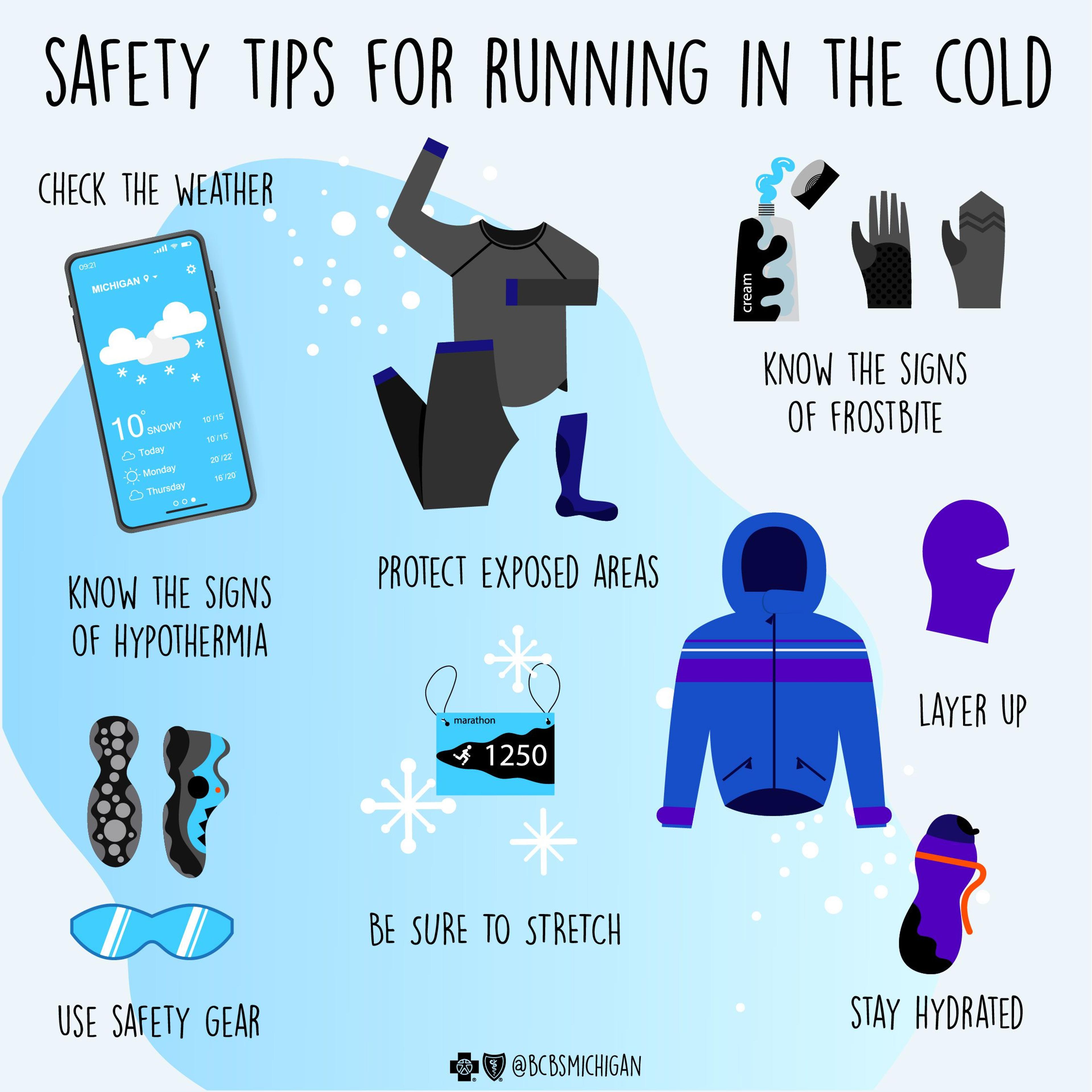Safety Tips for Running in Cold Weather

Abby Grant
| 4 min read

Many people use running to incorporate physical activity into their daily routine or as a way to destress after a long day. But when the weather gets colder many runners can become unmotivated to run outside in frigid temperatures.
Running is beneficial to your mental and physical health, so it is essential to prioritize running during the winter months when stress and anxiety are heightened by the added holiday stress.
However, running in the cold weather has added risk. The cold temperatures can make your heart work harder and can lower your threshold for exhaustion. Colder temperatures can also make breathing harder for some people, which can impact the lungs and irritate the airway.
Exercising outside is safe in cold weather, but it is important to take extra precautions when running this winter. As always, talk with a doctor before beginning any new exercise routine.

Here are some tips to try this winter:
Check the weather: Cold weather can make it more difficult to run, but certainly not impossible. However, it is important to check the weather when running in the cold weather. Check to make sure that the forecast doesn’t call for snow, rain, or high winds. These conditions can make you more vulnerable and can make running in the cold more difficult. If the weather is not safe, don’t take the risk.
Layer up: Dressing in layers is the best way to stay protected when running in cold weather. You don’t want to be underdressed and be too cold on your run, but overdressing can also be problematic. Dressing in layers can allow you to remove and replace layers depending on the weather and the intensity of your run. Avoid wearing cotton, which gets wet with sweat and stays wet – which can make you colder. Instead try wearing a base layer that will resist sweat absorption. Next, wear a layer for insulation and warmth before finishing with a breathable, waterproof outer layer. Every runner is different and it may take time to find what is best for you, but these are a great place to start when trying to learn how to layer.
Protect exposed areas: Areas such as your hands, ankles, ears and head may be exposed to the harsh outdoor weather while running. It is important to keep these areas protected while running to prevent windburn and frostbite. Consider wearing a light pair of gloves, long socks and a hat or ear warmers when you’re running to add an extra layer of protection this winter season.
Use safety gear: The amount of daylight gets shorter as the temperatures get colder, so it is important to wear reflective clothing and safety gear when running outside in the winter. Colder temperatures also can create icy conditions. Wearing running shoes with high traction can help you stay steady on your feet when running on potentially icy surfaces. Safety is imperative when running in cold weather.
Stay hydrated: Runners can quickly become dehydrated when running regardless of the temperature. It is important to hydrate before, after and while running in cold temperatures. You may not notice that you’re sweating in the cold, so dehydration can quickly sneak up on you.
Know the signs of frostbite or hypothermia: Frostbite can occur to any skin exposed to below zero temperatures. Early signs of frostbite include a stinging sensation on the skin, numbness and tingling or loss of sensation. If you are experiencing any of these symptoms, be sure to get out of the cold and warm the affected area slowly. Hypothermia is another potential concern when exercising outdoors in the winter. Hypothermia is when your body temperatures are too low. Early symptoms of hypothermia include fatigue, slurred speech, or intensive shivering. If experiencing feelings of hypothermia seek medical help immediately.
Check with your doctor: It is important to check with your health care provider before beginning any new exercise routine. Health care professionals can check for any conditions like asthma or heart problems that could lead to issues when exercising, especially in colder temperatures. It is always best practice to get a health care provider’s opinion if you are concerned about how exercising may potentially impact your health.
Don’t forget to stretch after a run, especially in the cold weather months.
Read more fitness content from AHM:
- 10 Everyday Ways to Maintain Strong Lungs
- The Difference Between Static and Dynamic Stretching
- Are You Doing These Things to Prevent Skin Infections at the Gym?
Photo credit: Getty Images





